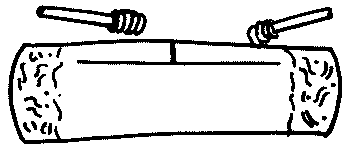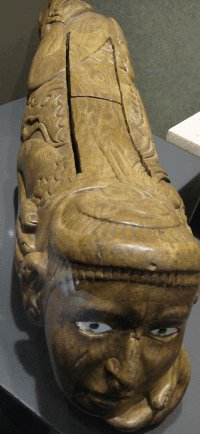Aztec Music
The importance of Aztec music in the lives of the citizens of the empire is hinted at in this quote from Spanish friar Gerónimo de Mendieta:
Each lord had in his house a chapel with composer-singers of dances and songs, and these were thought to be ingenious in knowing how to compose the songs in their manner of meter and the couplets that they had. Ordinarily they sang and danced in the principal festivities that were every twenty days, and also on other less principal occasions...
Aztec music was a constant and important part of life. Not only
was music used for enjoyment, it was a way of passing on culture, of
sharing an understanding of religion, of making an emotional connection
with the events of life.
When a child was sent to school, music
and the playing of instruments was an important subject to be learned.
Students between 12 and 15 would learn songs that were important in
their culture. And, as we see in the quote above, music was important
enough that the nobles often had their own band, song writers and studio
right at home. Elders in the home would teach children the songs they
needed to know.

The teponaztli, a sacred Aztec horizontal drum
Types of Aztec music
The Mexica people had various different types of music. Many of the songs were sacred hymns. These hymns would commemorate the deeds of great rulers, or, of course, the gods. The gods Ometeotl, Tlaloc, Huitzilopochtli and Tezcatlipoca
were all honoured in song. The sacred hymns would often tell stories
about things that the gods had done. These hymns would also be used to
ask the gods for rain or success in battle, or to thank the gods for
their gifts. These songs could be sung at special occasions,
accompanied by special ritual dances.
Another genre of Aztec music was the cantares. Linguist John Bierhorst
called these "ghost songs". They would often recount the great deeds
of the past, but they had more of a mystical purpose than the sacred
songs. These songs were specifically sung at times of battle.
Specially trained singers, dancers and actors would take part in the
ritual ceremony.
The spirit world was symbolically
portrayed, and the participants would work themselves into a trance as
they sang and danced for hours on end. It was believed that there was a
special connection with the ancestors and gods at this time. The
warriors would lose their inhibitions and be almost hypnotically drawn
to the battle. The battles of the past, and human sacrifices, would be
acted out in front of the people.
Of course, Aztec music also included the more lighthearted songs, and songs of everyday life.
Love songs, and songs of energy and excitement were played. The
cantares were only for religious ritual, but there were plenty of more
universal songs.
Unique characteristics of Aztec Music
The poetic and symbolic nature of the Nahuatl language and
writing systems was certainly carried over into their music. The
allusions and symbols would often be so obscure that we would understand
very little of a direct translation today. Writing soon after the
Spanish conquest, Diego Durán said that the songs would at first seem
like nonsense, but once he discussed the words and learned what they
meant, he came to admire the poetry and wording. Both the religious and
non-religious songs had this brilliant word play.
Each place, each god, each thing would often have multiple names. For example, if I spoke of where the smoke of shields diffuses, am I talking about a place? An event? What if I said flowers of the heart upon the plain?
Both of these phrases are speaking of the same thing: battle. Once
you know that, you can see the clever poetry in each phrase.
Music in the empire was a combination of dance, ritual, instruments, and vocals. Even whistling was incorporated into the music.
Aztec instruments

Drums played a big part in the music of the Aztecs. A variety of drums were used, including the ayotl (drum made from a turtle shell), teponaztli (horizontal log drum, played with mallets) and huehuetl (upright skin drum, similar to what we're most familiar with). The huehuetl was played with the hands and not drum sticks.
Drums would accompany music or be used alone,
for example to lead warriors into battle. Both these drums (teponaztli
and huehuetl) were considered special sacred instruments. It was
believed, in fact, that two gods were banished to the earth in the form
of these two drums.
Rattles were also common, and would be filled with beads or pebbles. Rattle sticks were also used.
To add the melody to the music, flutes of various kinds were very popular. The flute was called the huilacapitztli. Rattles and flutes are still very popular in Mexico today.
Various other horns and trumpets were used, such as the conch (tecciztli) and snail horn (quihquiztli).
Hear Aztec music
Here are some examples of Aztec music for you to listen to. First, a demonstration of the teponaztli and huehuetl in this video:
And from photojournalist Chico Sánchez, this fascinating look at some other instruments. The video is in Spanish, but you'll still get the sights and sounds even if you don't understand the language.
For more, you can hear some sounds of Aztec music from the teponaztli here, and finally an interesting discussion of symbols and drum beats in Aztec music.